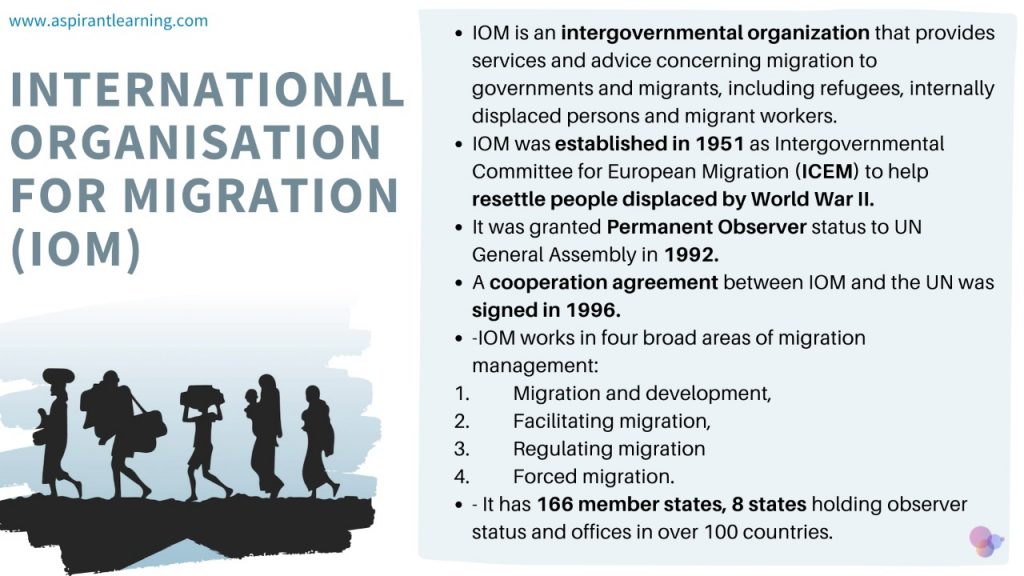News Highlight
It is a matter of grave concern that despite being the largest migrant-sending country, India has yet to have a tangible and comprehensive migration policy that upholds worker rights.
Key Takeaway
- This year, International Migrants Day (observed annually on December 18) must be seen in the backdrop of unprecedented volatility that began in 2020 due to the COVID-19 pandemic.
- Besides this infectious disease outbreak, there were events such as the Taliban takeover of Afghanistan, Russia’s invasion of Ukraine, worsening poverty in the sub-Saharan region, and climate change, resulting in large-scale migration.
Migration
- Migration occurs when an individual or a community moves from one location to another, typically across political and administrative borders.
- The movement of people from one place to another or from one country to another is called migration.
- The migration rate impacts a region’s population growth since it brings in more or fewer individuals.
- Migration can be classified as everyday, temporary, or permanent.
Causes of Migration
- Most people have strong emotional ties to their birthplace.
- However, many people move away from their homes and places of origin.
- There might be several causes.
- These explanations fall into two categories:
- Push factors prompt people to leave their homes or place of origin.
- Pull variables that draw people from various locations.
- People in India move from rural to urban areas primarily because of poverty, heavy land use pressure, and a lack of essential infrastructure like health care, education, etc.
- In addition to these elements, natural disasters can encourage migration, including floods, droughts, cyclones, earthquakes, tsunamis, wars, and regional conflicts.
- However, pull factors also draw inhabitants of rural areas to urban ones.
- Better possibilities, the availability of steady jobs.
- Generally, higher earnings are the main draws for most rural migrants to metropolitan regions.
- Better entertainment options, healthcare facilities, and educational prospects are all vital draw factors.
Migration to Gulf nations
- India leads the world in international migration and remittances, and the Gulf region alone is home to nearly 50% of all Indian migrants.
- Over 13.4 million non-resident Indians are living abroad, according to the Ministry of External Affairs.
- 64% reside in GCC nations, with Kuwait, Saudi Arabia, and the UAE having the most significant percentages.
- According to the International Labor Organization, around 90% of Indian migrants who reside in GCC nations are low- and semi-skilled labourers.
Problems faced by migrants
- Labour rights abuses
- In recent months, the media has extensively covered labour rights abuses at the Dubai Expo, stadium buildings for the World Cup in Qatar, and the Covid epidemic.
- Social security
- The Gulf Cooperation Council (GCC) nations have been charged with failing to offer employees access to social security benefits, employment, and healthcare services.
- Wage theft
- According to the Return Migration Survey, of the 47% of those who lost their jobs, 39% reported not getting paid or having their income reduced.
- Similar incidents of non-payment of salaries, breach of contract, and intimidation of workers were reported during the football stadium construction in Qatar for the upcoming FIFA World Cup.
- Occupational safety
- According to The Guardian reports, 6,500 migrant workers from South Asia have passed away in Qatar in the last 10 years, the majority of whom were Indians and mainly as a result of workplace risks.

Way Forward
- Instead of assigning blame in the circumstances like the pandemic and migrant mortality, there is a need for a collaborative effort to address the concerns of migrants.
- Creating a shared awareness of global labour mobility.
- Creating regional alliances: In the South Asia-GCC corridor, India should take the lead in establishing regional partnerships.
- Participating stakeholders A concerted effort from all parties, including the government, labour unions, employment agencies, and civil society, can result in significant reforms.
Pic Courtesy: freepik
Content Source: The Hindu



